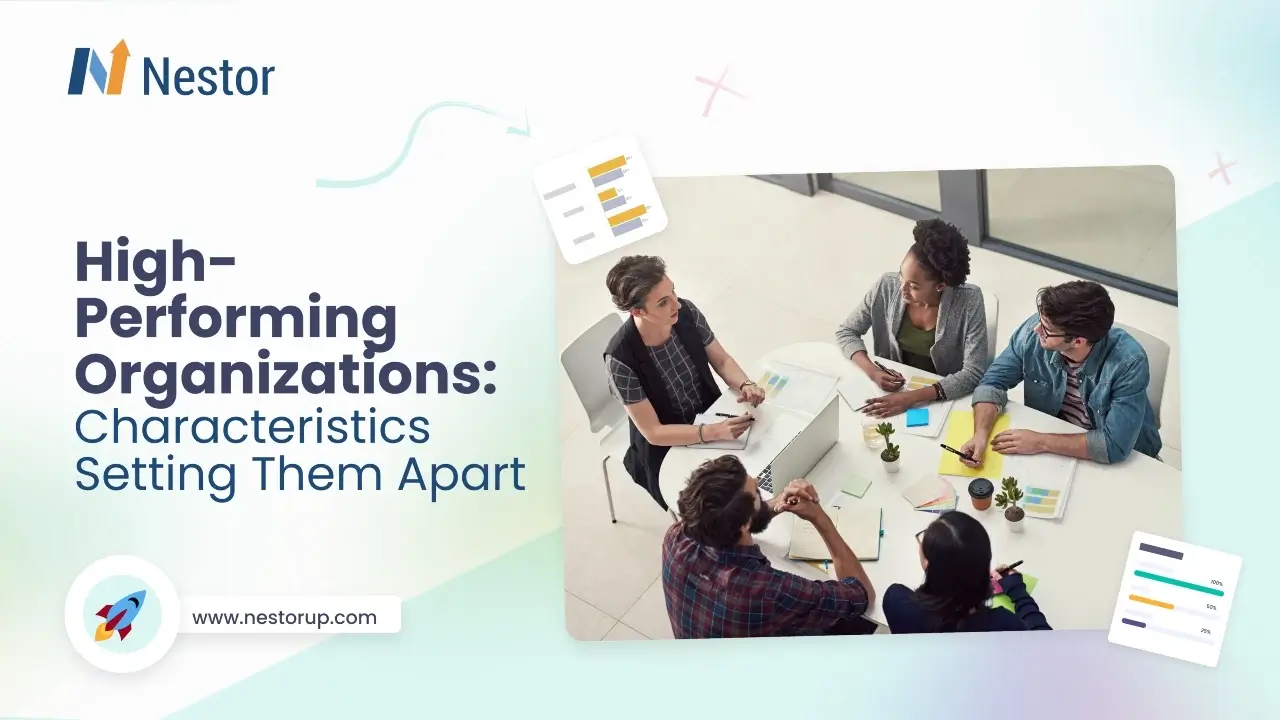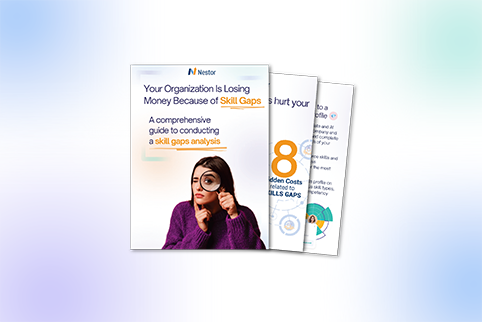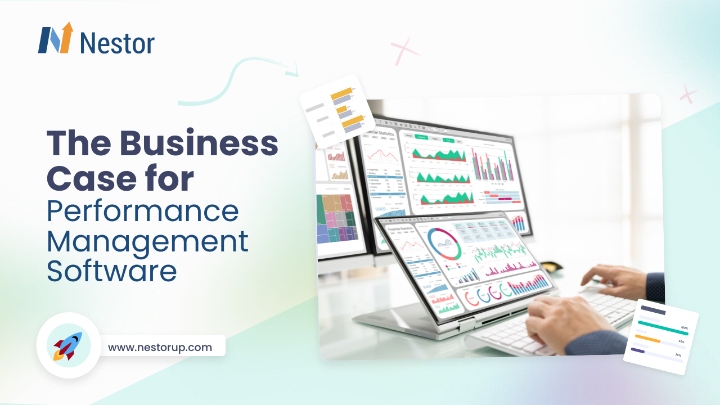High-Performing Organizations: Characteristics Setting Them Apart
19 min read

Contents
Ask ten leaders if they’re a part of high-performing organizations, and most will say yes. They’re hitting targets, customers are satisfied, and employees seem engaged; at least on paper. But scratch beneath the surface, and things get murkier.
Because being “high-performing” isn’t just about outcomes. It’s about how those outcomes are achieved and whether they’re sustainable in a world where change is the only constant.
The reality? Most organizations are still running on outdated models. Rigid hierarchies. Leadership styles that prioritize control over agility. And underneath it all, a disconnect between strategy and the people expected to execute it.
High-performing organizations flip that script. They bring clarity to culture, design around skills (not titles), support their managers, and act fast on what the data shows. And increasingly, they’re using platforms like Nestor to bring structure to that agility, making people and business strategies work as one.
So what exactly are these organizations doing differently? And how can HR lead the shift?
Today, we’re breaking it down: what high performance actually looks like today, what’s getting in the way for most teams, and how to start building smarter, faster, more resilient organizations from the inside out.
Let’s start with where it all begins: purpose.
What Are High-Performing Organizations (HPO)?
Before we start, let’s get one thing straight: being productive isn’t the same as being high-performing.
Lots of teams are busy. Goals get ticked off. Deadlines are met. But under the surface, there’s friction, misaligned priorities, and missed opportunities to innovate. Performance might look fine on a dashboard, but it’s fragile. It can’t stretch, evolve, or hold up under pressure.
High-performing organizations work differently.
High-performing organizations are companies that manage to significantly and regularly outperform their competitors and enjoy much better outcomes, across various business areas: finance (profitability), employees (expertise, quality of hires, and satisfaction), brand image (customer loyalty), etc.
These companies aren’t defined by a single practice or a specific tool. They’re defined by how consistently and intentionally they bring everything together (leadership, clarity, culture, and execution) into a system that actually works.
And while they might look different from the outside, most HPOs share the same foundational traits on the inside. We’ll walk through those next, starting with the one that anchors everything else.
Clear and Compelling Purpose
Purpose isn’t just a nice statement on your careers page. It’s a lens. When it’s real, and not just a branding exercise, it becomes the filter through which decisions are made, priorities are set, and people stay aligned when things get messy (which they will).
In high-performing organizations, purpose isn’t something you need to “remember.” It shows up in how teams work, how leaders lead, and how trade-offs are made under pressure.
Why Purpose Actually Matters for High-Performing Organizations
A clear mission does two things really well:
- It connects day-to-day work to something bigger.
- It keeps teams moving in the same direction, even when roles, goals, or strategies shift.
According to a Deloitte study, purpose-driven companies experience higher market share gains and grow three times faster on average than their competitors, all while achieving higher workforce and customer satisfaction.
Gallup research reinforces this, showing that employees who connect with their company’s purpose are more engaged, leading to increased innovation and productivity. To be more specific, just a 10% improvement in employees’ connection to the mission or purpose of their organization leads to a 4.4% increase in profitability and an 8.1% decrease in turnover.
In essence, purpose isn’t a soft concept; it’s a strategic asset.
Who’s Doing It Well?
Patagonia: Purpose as Operational DNA
Patagonia isn’t trying to be everything to everyone. Their mission “We’re in business to save our home planet” is specific, bold, and baked into every layer of the business.
This clarity shows up in their products, which prioritize reparability, sustainability, and environmental transparency. It’s in their activism, like urging customers to “Buy Less” or suing the U.S. government over national park protections. It’s in how they treat employees, from on-site childcare to paid time off for volunteering.
But perhaps the most defining moment came in 2022, when founder Yvon Chouinard announced he was giving away the entire company. Ownership was transferred to a trust and nonprofit created to ensure that all of Patagonia’s profits (estimated at $100 million a year) go toward fighting climate change. No IPO. No private equity. Just full alignment with their purpose.
This isn’t branding. It’s identity. It’s what happens when purpose becomes a filter for every decision, from supply chain to shareholder structure.
Unilever: Scaling Purpose Across Brands
While Patagonia shows what purpose looks like in a focused, founder-led business, Unilever proves it’s possible at global scale.
With a corporate mission to “make sustainable living commonplace,” Unilever has embedded purpose not just in its headquarters, but in how it builds, markets, and evolves its brands. Under their Sustainable Living Plan, Unilever has shifted resources toward brands that deliver both commercial value and measurable social or environmental impact.
The results speak for themselves:
- Their 28 Sustainable Living Brands (like Dove, Lifebuoy, and Hellmann’s) are growing 69% faster than the rest of the portfolio.
- These brands drive 75% of the company’s growth, showing that consumers reward companies that lead with values.
Importantly, Unilever doesn’t treat purpose as a corporate campaign. Each brand’s purpose is distinct, credible, and connected to the problems they aim to solve, whether it’s improving hygiene access, reducing plastic, or promoting self-esteem.
How to Craft a Purpose That Actually Guides You
Skip the clichés. Be specific. Your purpose should reflect what your company believes, who it impacts, and why it exists beyond short-term success.
Here’s a simple framework to shape it:
- Identify your core values: What do you stand for, and stand against?
- Understand stakeholder impact: Who benefits from your work, and how?
- Link it to the long game: What’s the future you’re building toward, and why does it matter?
A strong purpose makes decisions easier, focus sharper, and work more meaningful. And in high-performing organizations, it doesn’t live on a wall. It lives in the way people work.
Adaptive and Empowering Leadership
High-performing organizations don’t just have leaders. They cultivate leadership at every level. The best leaders today aren’t the loudest in the room or the ones with all the answers. They’re the ones who ask better questions, create space for others to lead, and adapt in real time.
What Is Adaptive Leadership?
Adaptive leadership, a concept developed by Harvard professors Ronald Heifetz and Marty Linsky, is about mobilizing people to tackle tough challenges and thrive amidst change. It’s not about having all the answers but about fostering an environment where collective problem-solving and learning are paramount.
Key principles include:
- Emotional Intelligence: Understanding and managing your emotions and those of others.
- Organizational Justice: Ensuring fairness in decision-making processes.
- Development: Encouraging continuous learning and growth.
- Character: Demonstrating integrity and authenticity.
These principles empower leaders to navigate complexity, embrace uncertainty, and drive meaningful change.
Characteristics of Leadership in High-Performing Organizations
In high-performing organizations, leaders:
- Create Psychological Safety: They build environments where team members feel safe to take risks and express ideas without fear of ridicule or punishment.
- Model Adaptive Behavior: They exemplify flexibility and resilience, showing how to navigate change effectively.
- Foster Collaboration: They encourage cross-functional teamwork and open communication.
- Empower Others: They delegate authority and encourage autonomy, enabling teams to make decisions and innovate.
Real-World Example: Satya Nadella at Microsoft
When Satya Nadella became CEO of Microsoft in 2014, he inherited a company known for its competitive internal culture and resistance to change. Recognizing the need for transformation, Nadella introduced a “growth mindset” philosophy, inspired by psychologist Carol Dweck, emphasizing learning from failures and continuous improvement.
Under his leadership:
- Microsoft shifted from a “know-it-all” to a “learn-it-all” culture.
- The company embraced open-source software and cloud computing.
- Strategic acquisitions, like LinkedIn and GitHub, expanded Microsoft’s ecosystem.
- Investments in AI, including a significant partnership with OpenAI, positioned Microsoft as a leader in the field.
These changes not only revitalized Microsoft’s culture but also contributed to its market value surpassing $3 trillion.
Leadership Development Tips
If you’re serious about building adaptive leadership, forget one-off workshops or “inspirational” off-sites. Real leadership development is ongoing, context-specific, and deeply embedded into how people lead every day.
To cultivate adaptive and empowering leadership within your organization:
- Start with self-awareness. The best leaders are constantly reflecting. Whether it’s a 360-degree review, coaching session, or even journaling after a tough decision, they take time to ask: “What could I have done differently?”
- Make feedback the norm, not an event. In HPOs, feedback flows in all directions: up, down, sideways. Managers don’t wait for performance review season to understand how they’re doing.
- Promote learning through action. Don’t just talk about adaptability. Create environments where leaders have to practice it.
- Give people room to lead before their title says so. Adaptive leaders often emerge when given ownership. Let high-potential employees lead initiatives, navigate change, and build influence early. Then coach them through it.
High-Trust, Collaborative Culture
Culture isn’t about free snacks or quirky slogans. It’s about how people behave when no one’s watching and whether they feel safe enough to speak up, take risks, and challenge the status quo.
Culture as a Performance Multiplier for High-Performing Organizations
A healthy culture doesn’t just feel good; it delivers results. According to a study by i4cp, companies with healthy cultures are 6 times more likely to have “fit” cultures, leading to significantly higher employee net promoter scores (eNPS) and increased employee engagement.
Moreover, McKinsey’s research indicates that organizations with strong cultures exhibit greater resilience and higher financial performance, even amidst complex and challenging environments.
The Power of Psychological Safety
Google’s Project Aristotle sought to understand what makes teams effective. The standout finding? Psychological safety. Teams where members feel safe to take risks and be vulnerable with one another outperform those where such safety is lacking .
Psychological safety fosters an environment where innovation thrives, mistakes are viewed as learning opportunities, and collaboration is the norm.
Elements of a High-Trust Culture
Building a high-trust, collaborative culture involves:
- Openness: Encouraging transparent communication and sharing of information.
- Accountability: Holding oneself and others responsible for actions and outcomes.
- Feedback Loops: Implementing regular, constructive feedback mechanisms.
- Inclusion: Valuing diverse perspectives and ensuring all voices are heard.
- Respect for Diversity: Embracing different backgrounds, experiences, and viewpoints.
These elements create an environment where employees feel valued, leading to increased engagement and performance.
Continuous Learning and Innovation
In high-performing organizations, learning isn’t confined to onboarding sessions or annual workshops. It’s embedded in the culture, driving innovation and adaptability. These organizations understand that fostering a growth mindset and providing avenues for continuous learning are essential for sustained success.
Growth Mindset as an Organizational Asset
Psychologist Carol Dweck’s research introduces the concept of a “growth mindset”: the belief that abilities and intelligence can be developed through dedication and hard work. This contrasts with a “fixed mindset,” where individuals see their talents as static traits. Organizations that cultivate a growth mindset encourage employees to embrace challenges, learn from feedback, and persist in the face of setbacks. This approach not only enhances individual performance but also drives collective innovation.
Learning-Focused Initiatives of High-Performing Organizations
Google’s 20% Time: Google implemented a policy allowing employees to dedicate 20% of their work time to projects they are passionate about, outside of their primary responsibilities. This initiative led to the creation of groundbreaking products like Gmail and Google News, demonstrating how giving employees autonomy can result in significant innovation.
Adobe’s Kickbox Innovation Kit: Adobe developed the Kickbox program to empower employees to develop and pitch new ideas. Each participant receives a red box containing resources, including a $1,000 prepaid credit card, to prototype their concepts. This structured yet flexible approach has fostered a culture of intrapreneurship and creativity within the company.
Building Learning Infrastructure as a High-Performing Organizations
To support continuous learning and innovation, organizations can implement the following strategies:
- Internal Learning Academies: Establish dedicated platforms offering courses, workshops, and resources tailored to employee development needs.
- Mentorship Programs: Pair experienced employees with newer team members to facilitate knowledge transfer and professional growth.
- Cross-Training Opportunities: Encourage employees to learn different roles within the organization, promoting versatility and a deeper understanding of the business.
- Feedback Mechanisms: Implement regular feedback loops, such as 360-degree reviews, to provide employees with insights into their performance and areas for improvement.
By integrating these elements into the organizational framework, companies can create an environment where continuous learning is not just encouraged but is a fundamental aspect of the workplace culture.
Strategic Use of Technology and Data
In high-performing organizations, technology it’s a strategic driver. These organizations leverage digital tools and data analytics to enhance agility, inform decision-making, and foster innovation.
Digital Maturity Drives Performance for High-Performing Organizations
Digital transformation is more than adopting new technologies; it’s about integrating digital capabilities into every aspect of the organization. According to McKinsey, companies that effectively implement digital and AI technologies outperform their peers by two to six times in total shareholder returns across various sectors.
However, success isn’t guaranteed. Gartner’s 2025 CIO Survey reveals that only 48% of digital initiatives meet or exceed business outcome targets. This shows the importance of a well-defined digital strategy and the need for continuous adaptation.
How Technology Enables High Performance
Automation: Automating routine tasks frees up employees to focus on strategic initiatives. For instance, automating data entry or report generation can significantly reduce errors and increase efficiency.
Analytics: Real-time data analytics provide insights that inform strategic decisions. By analyzing customer behavior, market trends, and operational performance, organizations can make data-driven decisions that enhance competitiveness.
Collaboration Tools: Platforms like Slack, Asana, and Notion facilitate seamless communication and project management, especially in remote or hybrid work environments. These tools help teams stay aligned, track progress, and collaborate effectively.
Skills-Based Approaches as the Pillar for Transformation
Let’s be blunt: job titles are outdated. They’re vague, inconsistent, and tell you almost nothing about what a person is actually capable of. When priorities shift overnight, relying on rigid role structures isn’t just inefficient. It becomes a liability.
That’s why high-performing organizations are making a major shift. Instead of managing talent by role, they’re managing it by skill. The difference? Precision, agility, and a workforce that can actually keep up with the business.
Why Skills, Not Just Roles, Are the New Foundation
Traditional role-based models are rigid by design. Great for predictability. Terrible for agility.
Skills-based organizations (SBOs), on the other hand, organize talent around capabilities. What can this person do? What could they learn next? Where can they add value right now, even if their title says otherwise?
This isn’t just theory. According to Deloitte, organizations that lean into skills-based structures are 63% more likely to outperform on business outcomes and 98% more likely to retain high performers. McKinsey adds that skills-first strategies also drive stronger internal mobility and unlock new pathways for development, especially for underrepresented talent.
What This Unlocks
Let’s break down why this shift matters:
- Agility: You can redeploy talent faster, staff new initiatives quickly, and fill gaps without waiting for a full reorg.
- Equity: You spot people with the right capabilities, even if they’ve been overlooked because they don’t “look” the part on paper.
- Retention: You give employees a clearer line of sight to how they can grow and what it’ll take to get there.
In short: it’s smarter, faster, and fairer.
How Nestor Powers Skills-Based Transformation
If all of this sounds great but hard to implement. This is where Nestor comes in.
Nestor is a skills-based talent platform that brings this vision to life. It helps organizations stop guessing and start acting on real skills data.
Here’s what it does:
- Skills Mapping: Get a real-time view of what skills exist, what’s missing, and who’s growing where.
- Personalized Development: Recommend learning journeys based on actual skill gaps, not just job level or tenure.
- Internal Mobility: Match people to projects, gigs, or roles based on what they can do today, not what title they currently hold.
- Connected Insights: Combine skills data with performance and engagement to make sharper, more strategic talent decisions.
In other words, it gives you a skills-first operating system for your people.
Getting Started with Nestor
Here’s a simple way to begin:
- Map what you’ve got: Use Nestor to assess your current workforce skills and identify the gaps. What do you have? What’s missing?
- Define what you need: Clarify the capabilities your business will need next. What will your organization need 6, 12, 18 months from now?
- Close the gap: Build targeted development paths, and let Nestor recommend internal talent to move into those roles before you even think about hiring externally.
This isn’t just an HR initiative. It’s a foundation for how modern organizations adapt, grow, and perform. Roles may change. Priorities will shift. But skills? Skills scale.
Customer-Centric and Market-Responsive
Some companies say they’re customer-focused. High-performing organizations prove it, every day, in every decision. They don’t just listen to customers; they build systems that adapt to them in real time.
Putting the Customer at the Core like High-Performing Organizations
No company embodies this better than Amazon. Their internal mantra “start with the customer and work backwards” isn’t just for leadership offsites. It’s operational. Teams across Amazon are empowered to make decisions based on what will serve the customer best, even if it means breaking process or sacrificing short-term gain.
- When Amazon rolled out one-day shipping, it wasn’t because competitors were doing it; it was because their customer data showed demand.
- When Alexa was developed, it came from analyzing how customers search, shop, and interact, not from chasing a trend.
Responsive Strategies That Actually Work for High-Performing Organizations
It’s not about just having the data. It’s about knowing how to use it.
- Real-time customer insights: Modern CRM platforms (like Salesforce or HubSpot) pull in behavioral, transactional, and sentiment data from multiple channels. This enables companies to see what customers are doing now, not just what they said in last quarter’s survey.
- AI-driven personalization: Tools like Adobe Experience Cloud allow brands to adjust digital content, product recommendations, and messaging on the fly, based on what each customer clicks, skips, or buys. The result? Experiences that feel made for them, even at scale.
- Proactive service over reactive support: Instead of waiting for customer complaints, HPOs set up early-warning systems (like predictive churn models or in-app behavior triggers) to engage before the problem escalates.
Measuring What Matters
High-performing teams don’t measure effort. They measure outcomes, and when it comes to customer-centricity, here’s what they track:
- Net Promoter Score (NPS): Want to know if your customers would recommend you? NPS is your benchmark. HPOs segment it, act on it, and tie it to team KPIs.
- Customer Lifetime Value (CLV): Not all customers are created equal. HPOs use CLV to prioritize where to invest, from loyalty programs to premium service experiences.
- Churn Rate: HPOs track churn not annually, but monthly (or even weekly), using it to trigger interventions before a customer walks.
Customer-centricity isn’t about being nice. It’s about being precise, responsive, and relentless about value, on the customer’s terms.
Final Thoughts on High-Performing Organizations
There’s no one-size-fits-all formula for becoming a high-performing organization, but there is a pattern.
The companies that consistently outperform aren’t doing it by accident. They’ve built systems that support clarity, trust, adaptability, and action. They’re clear on why they exist. They empower leaders who know how to navigate change, make learning part of the job and build cultures people want to be part of. And they use data and technology not as a layer of complexity, but as fuel for smarter decisions.
If you’re in HR, people strategy, or leadership, you’re steering this change. Whether you’re starting from scratch or leveling up what already exists, now’s the time to take stock.
Ask yourself:
- Is our purpose more than a paragraph?
- Are our leaders growing or just managing?
- Can we move fast when priorities shift?
- Do we actually know what skills live in our workforce?
- Are we building a culture that people want to stay in?
If you answered “no” or even “not sure” to any of those, this isn’t exactly a red flag. It’s a starting point. Because high performance isn’t a finish line. It’s a mindset.
Ready to make it real?
Nestor helps organizations move from ideas to action; connecting performance, development, and engagement through a skills-first platform that actually understands your people.
Whether you want to map workforce skills, build career paths, empower managers, or track progress in real time—Nestor gives you the clarity to move forward with confidence.
👉 Book a demo with Nestor and start building a high-performing organization from the inside out.
Frequently Asked Questions (FAQs) About High-Performing Organizations
What are high-performing organizations?
A high-performing organization is a company that consistently achieves outstanding results by aligning strategy, culture, leadership, and people development. These organizations are agile, data-driven, and focused on continuous improvement.
What are the characteristics of high-performing organizations?
High-performing organizations share core traits:
- A clear and compelling purpose
- Empowering, adaptive leadership
- A strong culture of trust and accountability
- Continuous learning and innovation
- Strategic use of data and technology
- Skills-based workforce planning
- Customer-first decision-making
Why is a skills-based approach important in HR?
A skills-based approach helps HR teams align people with business needs. Instead of relying on job titles, it focuses on what employees can actually do: making talent deployment, internal mobility, and development smarter and more equitable.
How do skills-based organizations improve agility?
Skills-based organizations can quickly shift people into new roles, projects, or priorities based on real-time capabilities. This flexibility makes them more resilient and responsive during change.
What metrics do high-performing organizations use to track success?
Common metrics include: Net Promoter Score (NPS), Employee engagement scores, Customer Lifetime Value (CLV), Churn rate, Skills gaps and development progress. These help track both internal performance and external impact.
What is an example of a high-performing organization?
Amazon is a prime example. It uses customer data, rapid experimentation, and decentralized decision-making to stay fast and customer-obsessed. Internally, it promotes innovation, clear principles, and ownership at every level.










